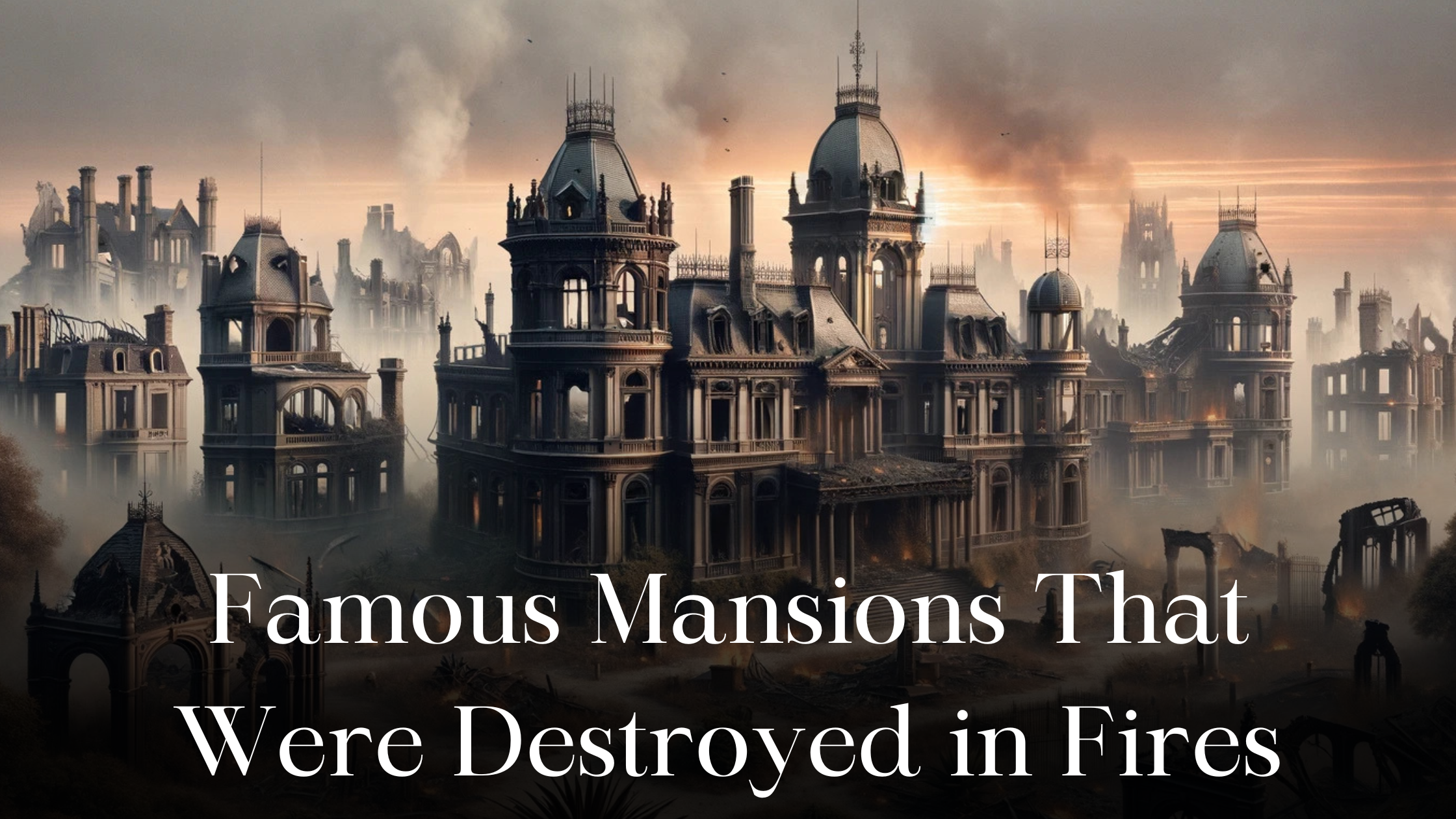Fires have tragically claimed some of the most beautiful mansions in history, leaving behind only memories and stories. These incidents reveal the fragility of architectural treasures and the impact of fire on cultural heritage. While some fires were caused by accidents, others were linked to vandalism or neglect.
Many famous mansions that stood for centuries were lost to flames, altering the landscape of their communities. From the grandeur of the Bidwell Mansion in Chico to other iconic estates, the loss is felt deeply by those who appreciate history.
Exploring these mansions helps keep their legacies alive, reminding everyone of their importance and the beauty they once held. Each story carries lessons about preservation and the need for vigilance against fire hazards.
Historical Significance of Mansions
Mansions often hold rich historical meanings and stories. They represent the culture, wealth, and architectural styles of their time. Each mansion can reflect the social dynamics of the era in which it was built.
For example, many mansions were symbols of power and prestige for influential families. These grand homes showcased detailed craftsmanship and unique designs. Their significance goes beyond beauty; they were often centers of social life.
Many famous mansions are linked to important events or people. They may have hosted political leaders, artists, or key cultural figures. This connection makes them important landmarks in history.
When a mansion is lost to fire, it impacts the community. The destruction can lead to a loss of heritage and history. People often feel a sense of mourning for these beloved structures.
Some mansions have been preserved, becoming museums. These sites allow visitors to explore history and the stories behind these stunning homes. They teach lessons about architecture, society, and resilience.
Common Causes of Mansion Fires
Mansions, like any other homes, can be vulnerable to fires. Understanding the common causes can help prevent devastating losses.
-
Cooking Accidents
Unattended cooking is a leading cause of house fires. Many fires start in the kitchen due to grease igniting or food burning. -
Heating Equipment
Faulty or improperly maintained heating sources, such as fireplaces and space heaters, can spark fires. Regular inspections and proper usage are essential for safety. -
Electrical Issues
Old wiring and overloaded circuits can result in electrical fires. It’s important to have professional electricians check older homes for any potential hazards. -
Candles
Candles can create a warm atmosphere, but they can easily ignite nearby objects. Using candle holders and keeping them away from flammable materials is crucial. -
Smoking Materials
Cigarettes and other smoking items can cause fires if not disposed of properly. They should be extinguished fully before being thrown away. -
Arson
Sadly, some mansion fires are deliberately set. Investigators often look into suspicious activities when a fire occurs.
Awareness of these causes helps people take precautions. Protecting a mansion from fire involves attention and care in daily activities.
Famous Mansions Lost to Fires
Many famous mansions have sadly been lost to devastating fires. These incidents not only affected the structures but also the stories and memories tied to them.
One notable loss is the Bidwell Mansion in Chico, California. This historic home caught fire early in the morning, leading to significant damage. The cause was linked to an illegal burn nearby. More details can be read in the article about the famous Bidwell Mansion.
Another tragic event occurred along the Pacific Coast Highway in Malibu. Several luxurious mansions, valued at millions of dollars, were destroyed. The fire forced thousands of residents to evacuate. Learn more about these incidents in the piece on Malibu fires and mansions.
Additionally, many celebrity homes were affected during these wildfires. For example, a mansion used in a popular TV series partially burned down, but thankfully, no one was inside. More can be found in the report on celebrity homes affected.
These losses remind everyone of the power of nature and the importance of fire safety in preserving such historic sites.
Impact on Heritage and Architecture
Fires have significantly affected heritage and architecture throughout history. They not only destroy physical structures but also erase cultural history and artistry.
When a famous mansion burns, it often takes with it unique architectural features. These include intricate moldings, beautiful frescoes, and craftsmanship that may never be replicated. For example, the loss of the Crystal Palace in London was a blow to both design and engineering innovation.
Communities feel a deep sense of loss after a historic mansion is destroyed. Often, these buildings serve as symbols of local heritage. They carry stories and memories for those who lived nearby, which adds to their emotional significance.
In many cases, fires have prompted discussions about preserving architectural heritage. This has led to stronger fire safety regulations and the protection of similar structures. Communities are inspired to find ways to honor the past while planning for the future.
Additionally, the aftermath can spark interest in rebuilding efforts. Some choose to recreate the original design, while others seek new interpretations. These choices reflect a blend of honoring heritage and embracing modern creativity.
Fire Prevention and Safety in Historic Buildings
Fire prevention is crucial for protecting historic buildings. These structures often contain valuable artifacts and unique architectural features. Here are some key practices to enhance safety:
1. Regular Inspections
Conduct frequent inspections of electrical systems and heating equipment. This helps identify potential hazards early.
2. Fire Alarms and Sprinkler Systems
Install modern fire alarm and sprinkler systems. These technologies can quickly detect and extinguish fires, minimizing damage.
3. Fire-Resistant Materials
Use fire-resistant materials during restoration. This can help slow down the spread of fire and protect the building’s integrity.
4. Safe Storage Practices
Store flammable materials safely away from heat sources. Proper storage reduces the risk of fires starting unexpectedly.
5. Emergency Plans
Develop and practice an emergency evacuation plan. Everyone involved should know exit routes and assembly points.
6. Training Staff
Train staff in fire safety and response. Knowledge about what to do in case of a fire can save lives and valuable items.
By following these practices, historic buildings can be protected from the devastating effects of fire. With proper precautions, they can continue to be places of beauty and history for many years to come.
Restoration Efforts and Challenges
Restoring famous mansions after a fire can be a complex task. Experts face many challenges, from assessing damage to ensuring historical accuracy.
Key efforts in restoration include:
-
Documentation: Every piece of the damaged structure is carefully recorded. This includes charred timbers and fragments of glass. This helps professionals understand what needs to be restored.
-
Material Matching: Finding the right materials can be tough. It’s important to match colors and textures to keep the house’s original look.
-
Expert Craftsmen: Skilled artisans are often needed to replicate intricate designs. Their expertise ensures that the restoration honors the mansion’s history.
Common challenges faced:
-
Budget Constraints: Restoration projects can be expensive. Funding often plays a critical role in determining the scope of work.
-
Building Regulations: Historical buildings have strict guidelines. These regulations must be followed during restoration to preserve their significance.
-
Unexpected Findings: Sometimes, restorers uncover issues not seen before. This can add time and costs to the project.
Memorials and Remembrance
After a mansion is lost to fire, communities often find ways to remember this piece of history. Memorials can serve as a tribute to the architectural beauty and significance of these homes.
Many towns hold ceremonies to honor the memories of these structures. These events may include placing plaques or planting trees near the site of the lost mansion.
In some cases, artistic representations are created. Local artists might design sculptures or murals that celebrate the mansion’s legacy.
Examples of Memorials:
- Plaques: Commemorative plaques placed at the site.
- Plantings: Trees or gardens established in remembrance.
- Art Installations: Sculptures representing the lost beauty.
Communities also share stories about the families who lived in these homes. This sharing helps keep their legacies alive, ensuring that future generations know about their cultural significance.
By honoring these structures, people preserve their memories and celebrate the history that they represented. Through these efforts, even lost mansions continue to impact their communities.

